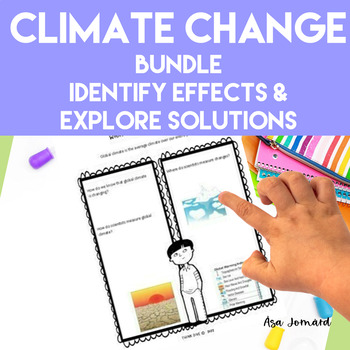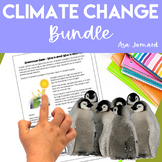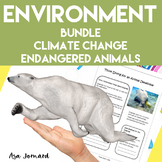Science Climate Change Bundle | Compatible with NGSS
- Zip
- Easel Activity
- Easel Assessment
Products in this Bundle (2)
Also included in
- Provide your students with detailed and engaging materials to help them gain an understanding of changes in our climate. How does climate change affect animals? Can animals adapt to the changes? Who is Greta Thunberg? What are fossil fuels? The included resources aim towards sparking an interest inPrice $9.00Original Price $12.50Save $3.50
- This Environment Bundle contains everything you need for meaningful, and engaging activities for Science in your classroom. Students will be encouraged to search for positive solutions while they are exploring challenging topics such as endangered animals, plastic pollution, and recycling. There isPrice $15.00Original Price $22.50Save $7.50
Description
If you teach about climate change, you know there is a wide range of content for students to explore. This Science Bundle contains everything you need for meaningful, and engaging activities about the changes in climate. You'll save time by purchasing this easy-to-use introduction to environmental issues.
As the earth gets warmer and warmer the causes, mechanisms, or impacts of climate change on our planet is something that is important to discuss with young children. It is also crucial to explore solutions and ideas that can help us build a better future. This project based learning unit focuses on identifying effects and exploring solutions.
What are you waiting for? Purchase this educational and engaging resource now and give your students science activities they'll love.
This resource has been prepared so that your students can use it on digital devices. I have selected suitable slides for you, you need to insert text boxes and you can also add instructions for your students. There is also a short assessment with a couple of questions.
Contact me at maliasa@live.com if you have any questions, thanks.
Please click the PREVIEW button above to get an idea of everything included.
Want a resource about Greta Thunberg? Check out Greta Thunberg - Explore suggestions & Solutions
You may like the Environment Bundle | Project Based Learning NGSS
Leaving feedback when you purchase a resource earns you points toward FREE TPT purchases. I love that feedback!
Also, Follow Me and be notified when new products are uploaded. New products are always 50% off for the first 72 hours they are posted.
Reviews of other Think Dive - Sparking Children's Thinkibility products:
Project based learning: Bats, STEAM, Biomimicry
"This product is absolutely the favorite one I have purchased all fall! I love the information that is provided about bats - just enough to intrigue and encourage higher level thinking. There are graphic organizers, worksheets, and subtle suggestions to help young learners perform at their best! And best of all, it stretches their creativity! Thanks for such an amazing resource!"
Project based learning: Mammals, Reptiles & Amphibians - STEAM, Biomimicry, NGSS
"Used this for a Kindergarten STEAM club unit and it was a hit!"
Why am I qualified to write these biomimicry resources? In 2015, I completed a course in Making Sense of Climate Change Denial at the University of Queensland. I was a member of BEN - Biomimicry Education Network - and a curator of educational resources at BEN. I am the author of the book Biomimicry with Theo & Tuva: Nature spotting inspires wild ideas. In 2015, I completed a course in Biomimicry: A Sustainable Design Methodology at Minneapolis College of Art and Design. I took part in the Biomimicry Design Challenge in 2021.
Product Format:
• This download is a PDF and is formatted in US Letter size. If you would prefer an alternate sizing A4 or spelling (colour vs color etc.), please leave me a note in the ‘ask a question section of my store'.
#climatechange #nature #sparkingchildrensthinkibility #thinkdive #asajomard #tpt




